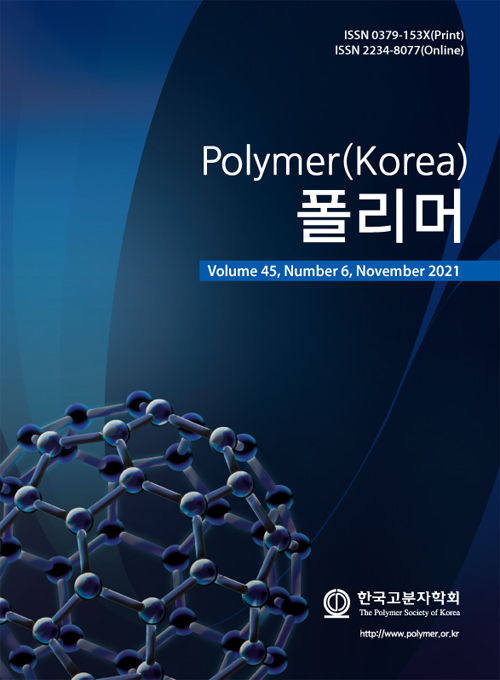- Thiophene-benzimidazolium Polymer Salts: Synthesis, Characterization, Antimicrobial Activities, and Evaluation in Terms of Occupational Health
Savas Kanbur, Gulcin Ozcan Ates, Sinem Altinisik*, Ulas Cinar**, and Fatma Baycan***,†

Department of Medical Services and Techniques, Canakkale Onsekiz Mart University, Canakkale, Turkey
*Department of Chemical Engineering, Faculty of Engineering, Canakkale Onsekiz Mart University, Canakkale, Turkey
**Occupational Health and Safety Education Application and Research Center, Canakkale Onsekiz Mart University, 17100 Canakkale, Turkey
***Department of Chemistry, Faculty of Arts and Sciences, Canakkale Onsekiz Mart University, Canakkale, Turkey- Thiophene-benzimidazolium 고분자 솔트: 합성, 특성분석, 항균활동 및 산업건강측면에서의 평가
Reproduction, stored in a retrieval system, or transmitted in any form of any part of this publication is permitted only by written permission from the Polymer Society of Korea.
A new thiophene benzimidazole based polymer (TBIP) was synthesized and then the TBIP-Br, TBIP-BF4 and TBIP-ClO4 polymer salts were obtained in water. All polymer salts can be dissolved in environmentally friendly solvents such as water or ethanol. Electrochemical and optical properties of the polymers were elucidated with cyclic voltammetry (CV) and ultraviolet-visible absorption (UV-Vis) spectroscopy. By using CV, the highest occupied molecular orbital (HOMO) values were found as approximately 1.70 eV. According to the atomic force microscopy (AFM) images of the thin film of TBIP, there are homogeneously distributed and smaller particles on the film surface, while the surface of TBIP-Br and TBIP-ClO4 thin films is rougher due to -Br and -ClO4 counter ions being bigger than -BF4. Additionally, the antimicrobial activity of TBIP polymers was also investigated. All TBIP and its salts were showed antimicrobial activity against S. aureus ATCC 6538 and no antimicrobial activity against E. coli ATCC 1301 and ATCC 25922.
Keywords: benzimidazole polymer, thiophene, antimicrobial activity, polymer salts, occupational health.
- Polymer(Korea) 폴리머
- Frequency : Bimonthly(odd)
ISSN 0379-153X(Print)
ISSN 2234-8077(Online)
Abbr. Polym. Korea - 2023 Impact Factor : 0.4
- Indexed in SCIE
 This Article
This Article
-
2021; 45(6): 817-823
Published online Nov 25, 2021
- 10.7317/pk.2021.45.6.817
- Received on Feb 25, 2021
- Revised on Jul 22, 2021
- Accepted on Jul 27, 2021
 Correspondence to
Correspondence to
- Fatma Baycan
-
Department of Chemistry, Faculty of Arts and Sciences, Canakkale Onsekiz Mart University, Canakkale, Turkey
- E-mail: fatmabaycan@comu.edu.tr









 Copyright(c) The Polymer Society of Korea. All right reserved.
Copyright(c) The Polymer Society of Korea. All right reserved.